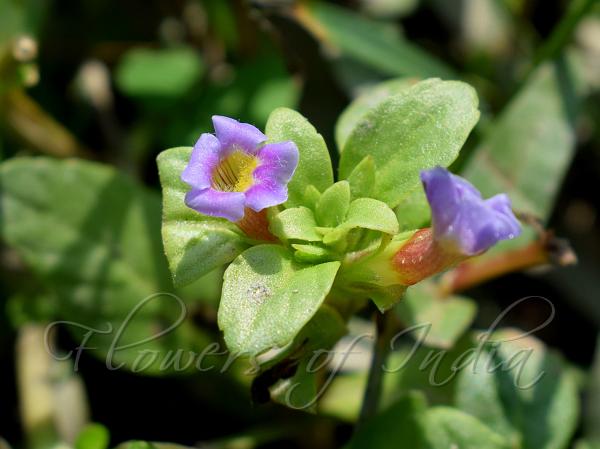|
| Wrinkled Marshweed |
|

|

| File size | 504258 |
| Original date | 10/15/17 11:08 AM |
| Resolution | 2048 x 1536 |
| Flash | Flash did not fire |
| Focal length | 55.0mm |
| Exposure time | 1/640s |
| Aperture | 8.0 |
| Focus Distance | |
| Metering Mode | Center weighted average |
| Camera make | NIKON CORPORATION |
| Camera model | NIKON D5300 |
| Sensor type | OneChipColorArea |
|
|
|
|
Photo: |
Botanical name: Limnophila rugosa Family: Plantaginaceae (Plantain family)
Synonyms: Herpestis rugosa, Gratiola rugosa
Synonyms: Herpestis rugosa, Gratiola rugosa
Wrinkled Marshweed is an erect, semi-aquatic,
fragrant, perennial herb, growing up to 50 cm tall. Stem is simple or
branched, rooting at lower nodes, then ascending up to 16 cm high,
bristly. Leaves are ovate-lanceshaped to ovate-elliptic, 1.6-4 x
0.7-1.7 cm, tapering to base, somewhat pointed at tip, entire to
rounded toothed-minutely toothed, penninerved, with nerves impressed
above, hairless to rough above, hairy on nerves beneath; leaf-stalk
7-10 mm long, densely hairy. Flowers are borne solitary in leaf-axils,
stalkless, blue with yellow in the throat. Sepals are divided to base,
unequal, lanceshaped, up to 7 x 1 mm, tapering, minutely bristly
without. Flowers are up to 1 cm long, hairy outside. Capsule is broadly
ovoid, 5 mm long, invested by longer sepals. Wrinkled Marshweed is
found in SE Asia. In India it is found from Punjab to Sikkim, NE India
till altitudes of 900 m, and in South India. Flowering: August-January.
Medicinal uses: A decoction of the leaves,
combined with Ocimum basilicum, is drunk as a treatment for mild
gonorrhoea and impotence. The plant is used in the treatment of coughs
and colds. Both a decoction and a steam-bath of the aromatic leaves are
used to cure itching eyes.
A decoction of the leaves,
combined with Ocimum basilicum, is drunk as a treatment for mild
gonorrhoea and impotence. The plant is used in the treatment of coughs
and colds. Both a decoction and a steam-bath of the aromatic leaves are
used to cure itching eyes.
Medicinal uses:
 A decoction of the leaves,
combined with Ocimum basilicum, is drunk as a treatment for mild
gonorrhoea and impotence. The plant is used in the treatment of coughs
and colds. Both a decoction and a steam-bath of the aromatic leaves are
used to cure itching eyes.
A decoction of the leaves,
combined with Ocimum basilicum, is drunk as a treatment for mild
gonorrhoea and impotence. The plant is used in the treatment of coughs
and colds. Both a decoction and a steam-bath of the aromatic leaves are
used to cure itching eyes. | Identification credit: N Arun Kumar | Photographed in Gaindikhata, Uttarakhand. |
• Is this flower misidentified? If yes,